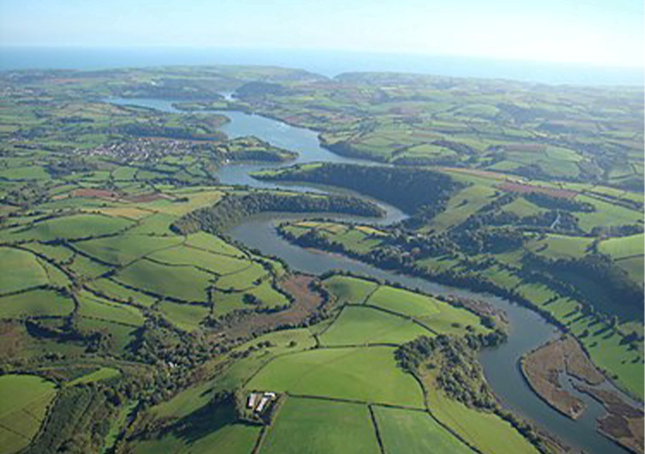River Dart

The River Dart is a river in Devon, England, that rises high on Dartmoor and flows for 75 kilometres (47 mi) to the sea at Dartmouth.
The river’s name is presumed to be Brythonic Celtic meaning ‘river where oak trees grow’ due to the banks of the lower Dart being covered in ancient woods of native oak. The Cornish word for oak is derow; alternatively the word for water is dowr, the probable source of other British hydronyms such as Derwent Water. Bray notes in 1832 that the name was occasionally spelled ‘Darant’.
The river begins as two separate branches (the East Dart and West Dart), which join at Dartmeet. The paths along these rivers offer very attractive walking, and there are several small waterfalls. The rivers are crossed by a number of clapper bridges, notably at the hamlet of Postbridge.
After leaving the moor, the Dart flows southwards past Buckfast Abbey and through the towns of Buckfastleigh, Dartington and Totnes. At Totnes, where there is a seventeenth-century weir (rebuilt in the 1960s),[5] it becomes tidal, and there are no bridges below the town.
A passenger ferry operates across the river from the village of Dittisham to a point adjacent to the Greenway Estate.
Formerly the home of the late crime writer Agatha Christie, this has stunning views across the river, and the house and gardens are now owned by the National Trust and are open to the public.-
The Dart estuary is a large ria and is popular for sailing. The village of Kingswear and town of Dartmouth are on the east and west sides of the estuary, and are linked by two vehicle ferries and a passenger ferry. The Kingswear Regatta is held each year. The deep water port of Dartmouth is a sheltered haven.
The entrance to the river from the sea is a rocky entrance with cliffs either side. On the East side Kingswear Castle sits very close to the water’s edge, and on the west side Dartmouth Castle is built on a rocky promontory at sea level. The castles once operated a defensive chain across the estuary, which was raised at dusk to destroy enemy ships attempting to attack the harbour. The remains of the operating mechanisms for the chain are still visible in Dartmouth castle.
